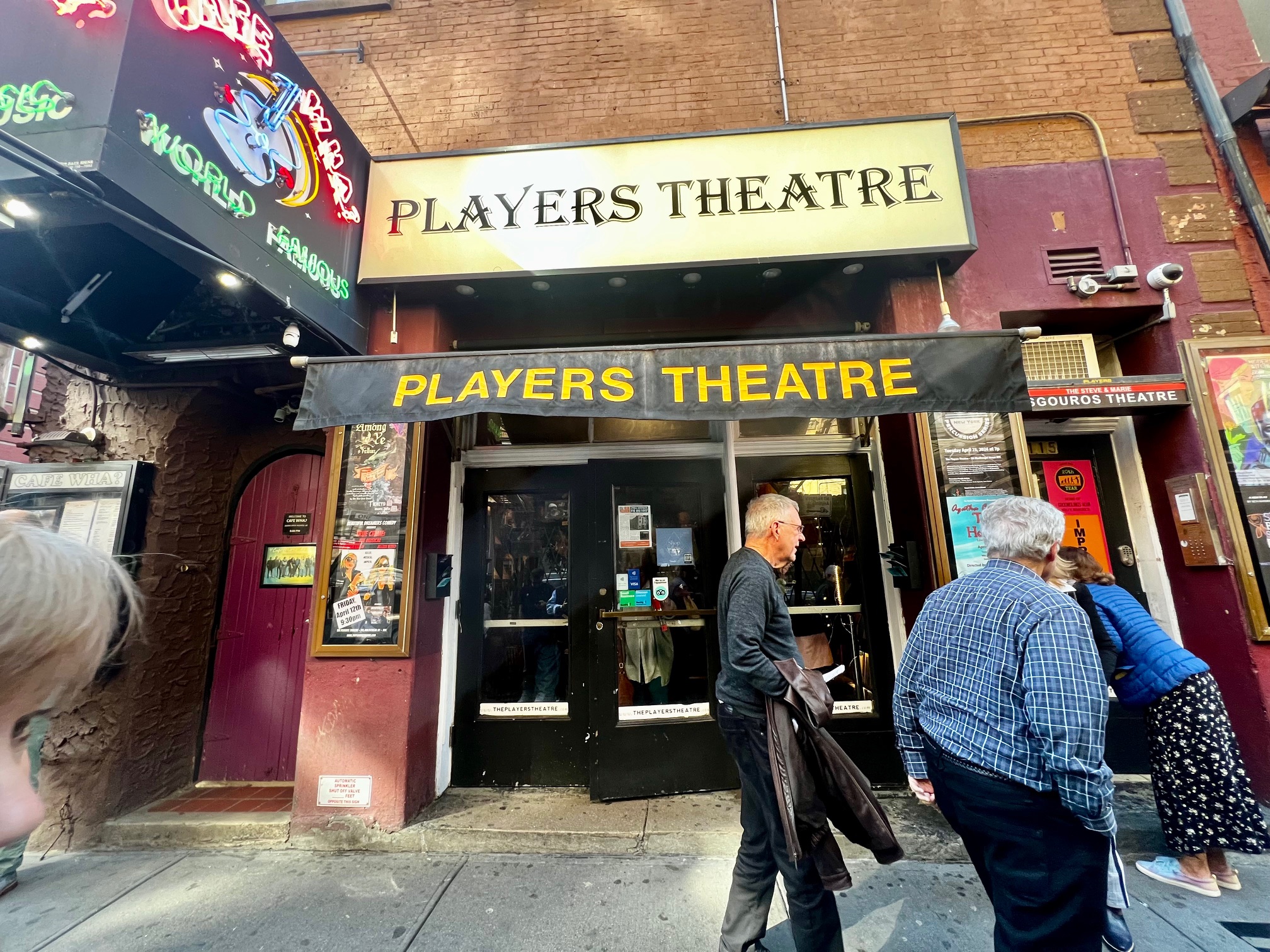 | ||||
 | ||||


example: Neil Young's 
• POP CULTURE - NEW YORK: THE ULTIMATE LOCATION FINDER, based on PopSpots, has maps to over 2,000 Pop Culture locations you can visit in New York CIty. RELEASED IN 2018! Ask for it it at your at your local bookstore, or buy it online from Amazon, Barnes and Noble, Target, Walmart and other online dealers. Read about it here. To be notified of new PopSpots and "PopSpot Singles" entries, follow PopSpotsNYC on Twitter:
Follow PopSpots on Facebook 
For questions or comments, you can email me, Bob Egan, here. Reference section: 
click here to see ongoing Dylan Research and also selected art, film, and history PopSpots-in-progress. PopSpots in the media. 
Looking for a free and extremely simple online method to learn HOW TO PLAY GUITAR? 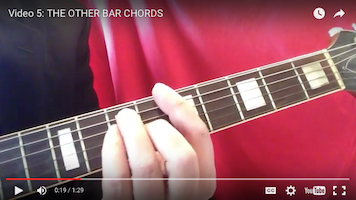
Or, just looking for a list of over 250 easy-to-play 3-chord and 4-chord songs? Click here to get to the website for: Bob Egan's MOST EXCELLENT LIST OF 3-CHORD and 4-CHORD SONGS" For The PopSpots Guide to Bookstores in NYC, click here.
|
Cafe Wha? - A look through the famed nightspot today, followed by photographs from its heyday in the 1960's. From Wikipedia: "Cafe Wha? is a music club at the corner of MacDougal Street and Minetta Lane in the Greenwich Village neighborhood of Manhattan, New York City. The club is important in the history of rock and folk music, having presented numerous musicians and comedians early on in their careers, including Bob Dylan, Jimi Hendrix, Bruce Springsteen, the Velvet Underground, Kool & the Gang, Peter, Paul and Mary, Woody Allen, Lenny Bruce, Joan Rivers, Bill Cosby, and Richard Pryor." See the end of the entry for more history. This is a photo of the Cafe Wha? in 2024. The Cafe Wha? music club is in the basement. One enters from the door on the left under the Cafe Wha? sign. The building also includes a 200+ seat Off Broadway theatre called the Players Thearer, and upstairs - the 50 seat Steve and Marie Sgouros theatre, four rehearsal studios, and an office suite for arts organizations. (click to ENLARGE PHOTO) 
Cafe Wha? in 2024. . Cafe Wha? entrance. Macdougal Street at Minetta Lane. 
Signs outside. 
Its history - part 1. 
Its history - part 2. 
The front door. The hours of operation. Entrance down the steps. 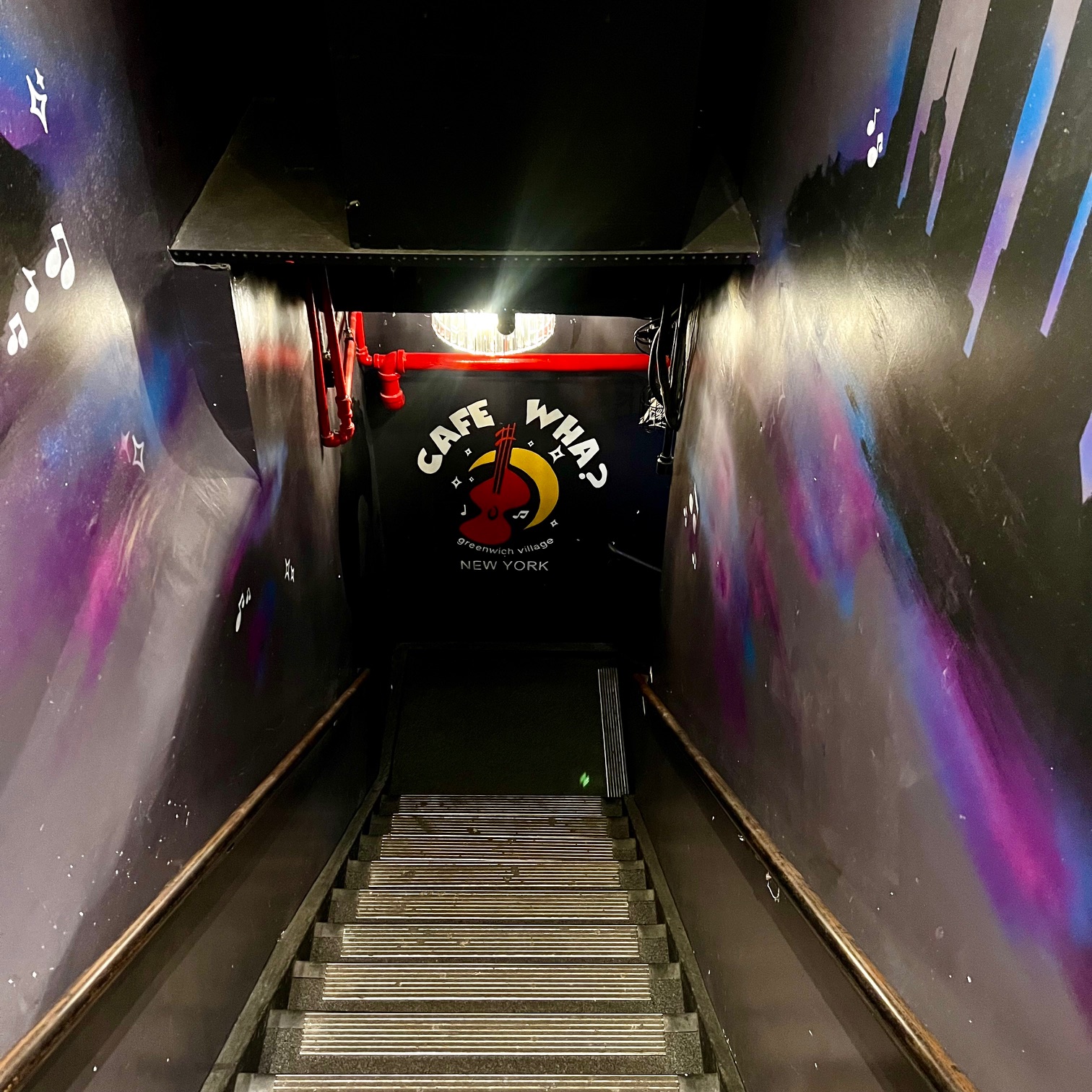
The lobby downstairs. 
The store. 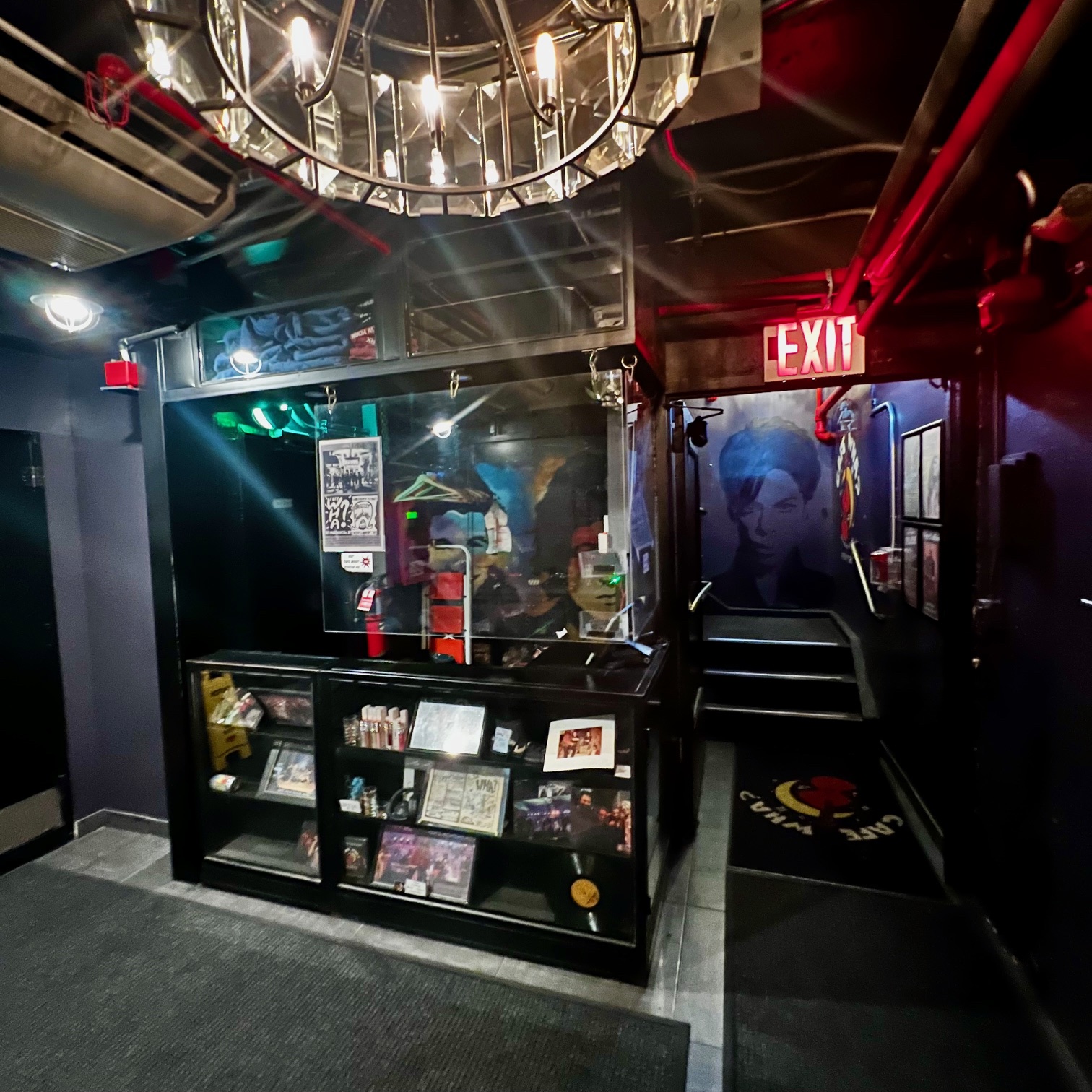

Posters for sale - part 1. 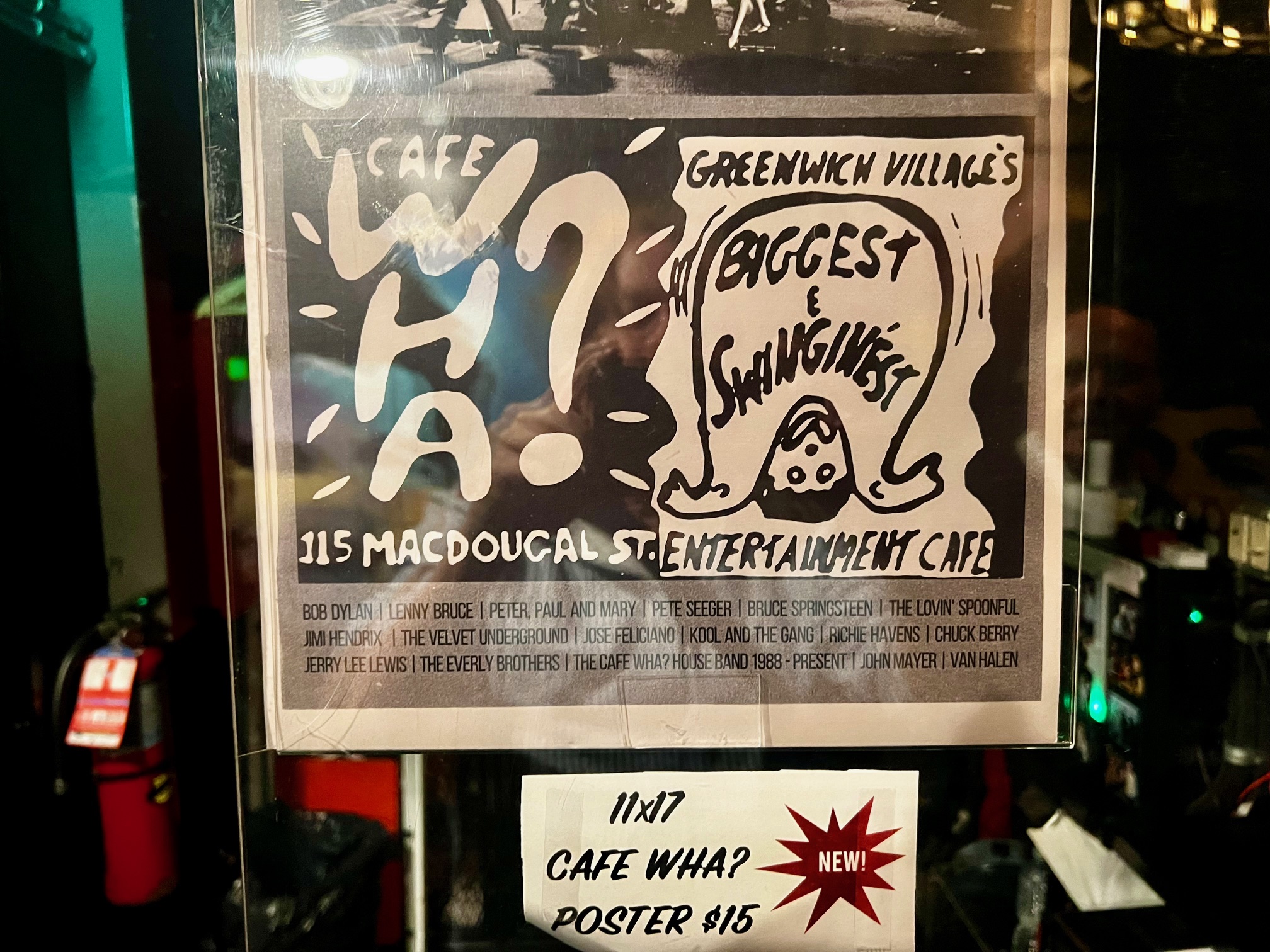
Posters for sale - part 2. 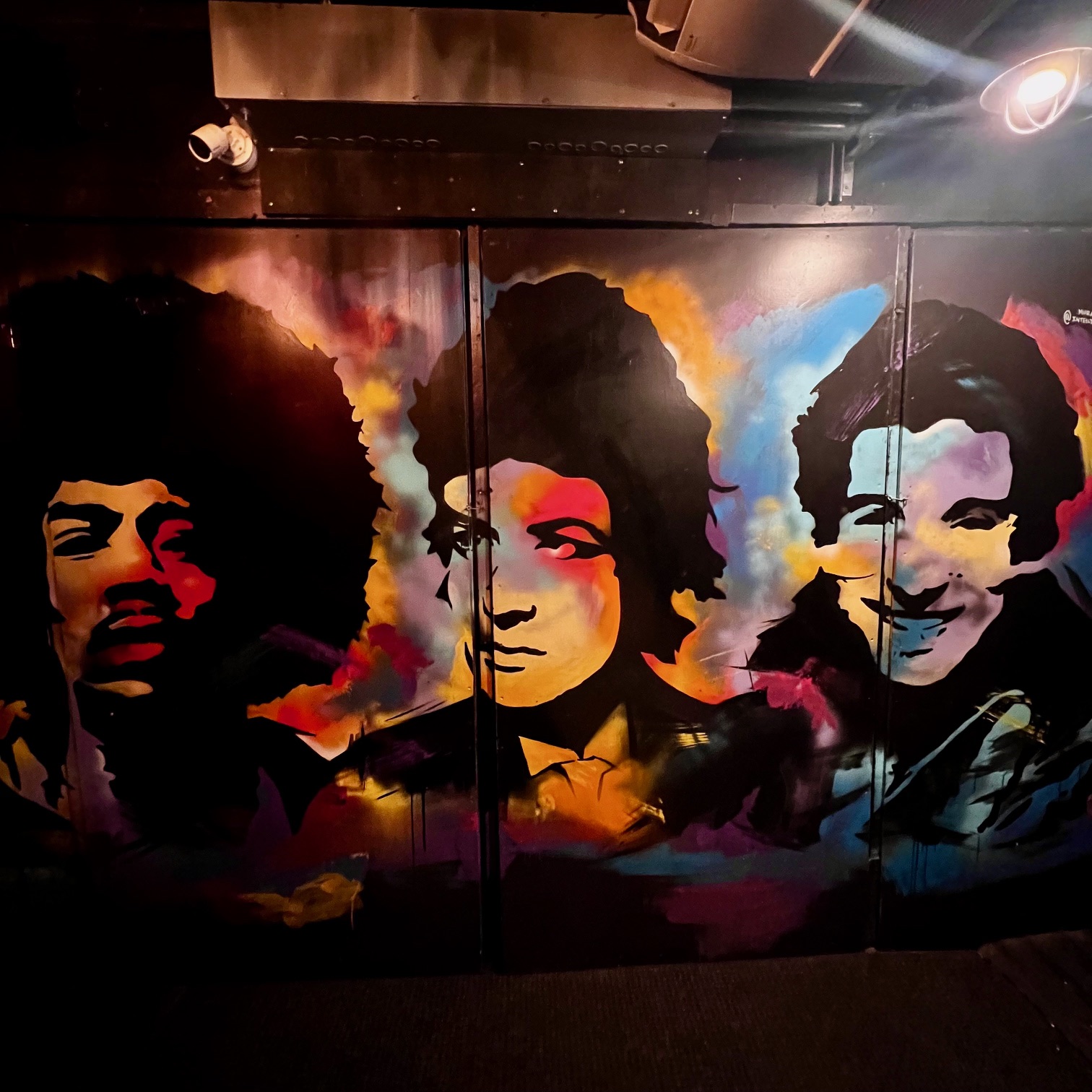






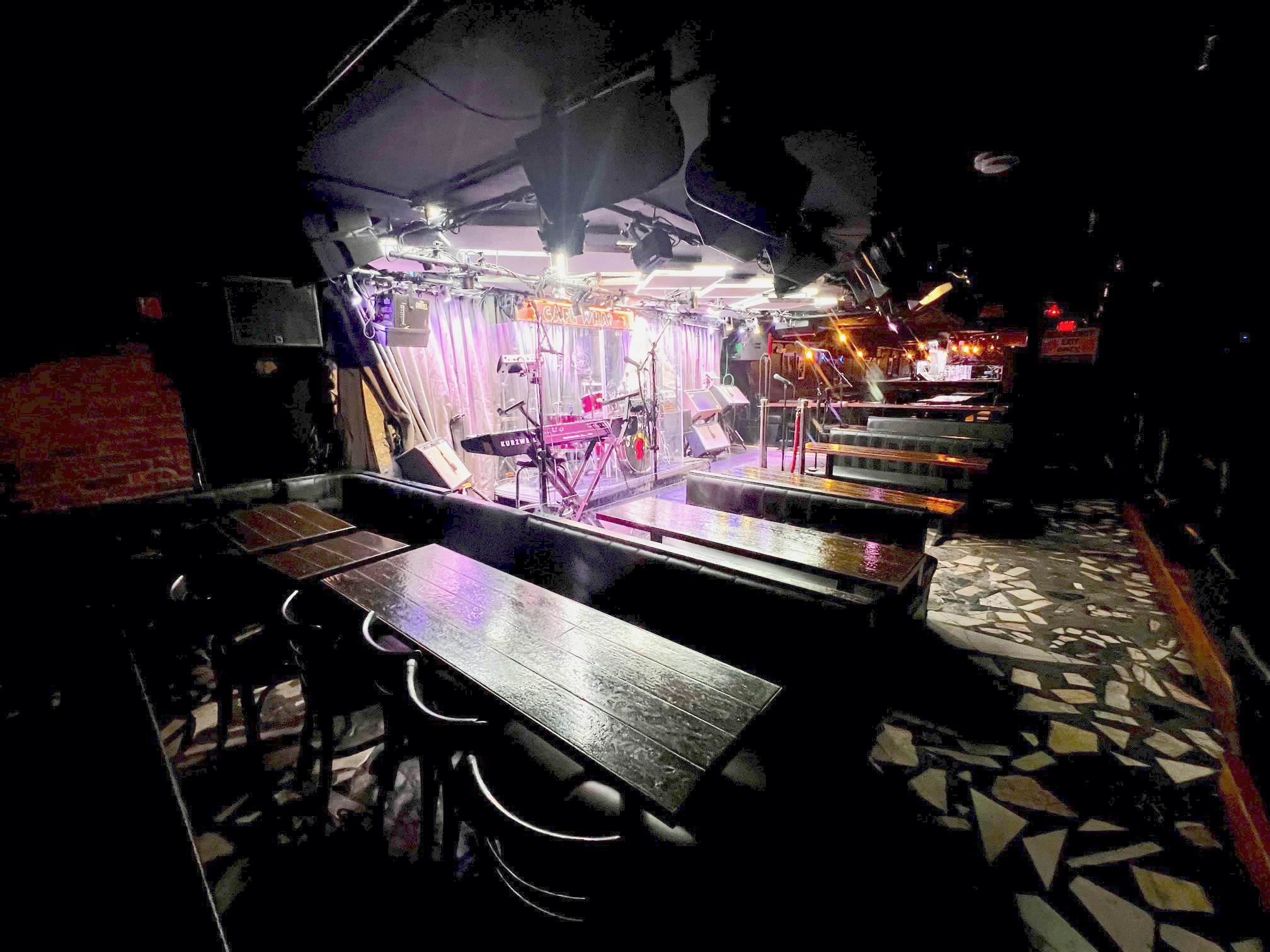






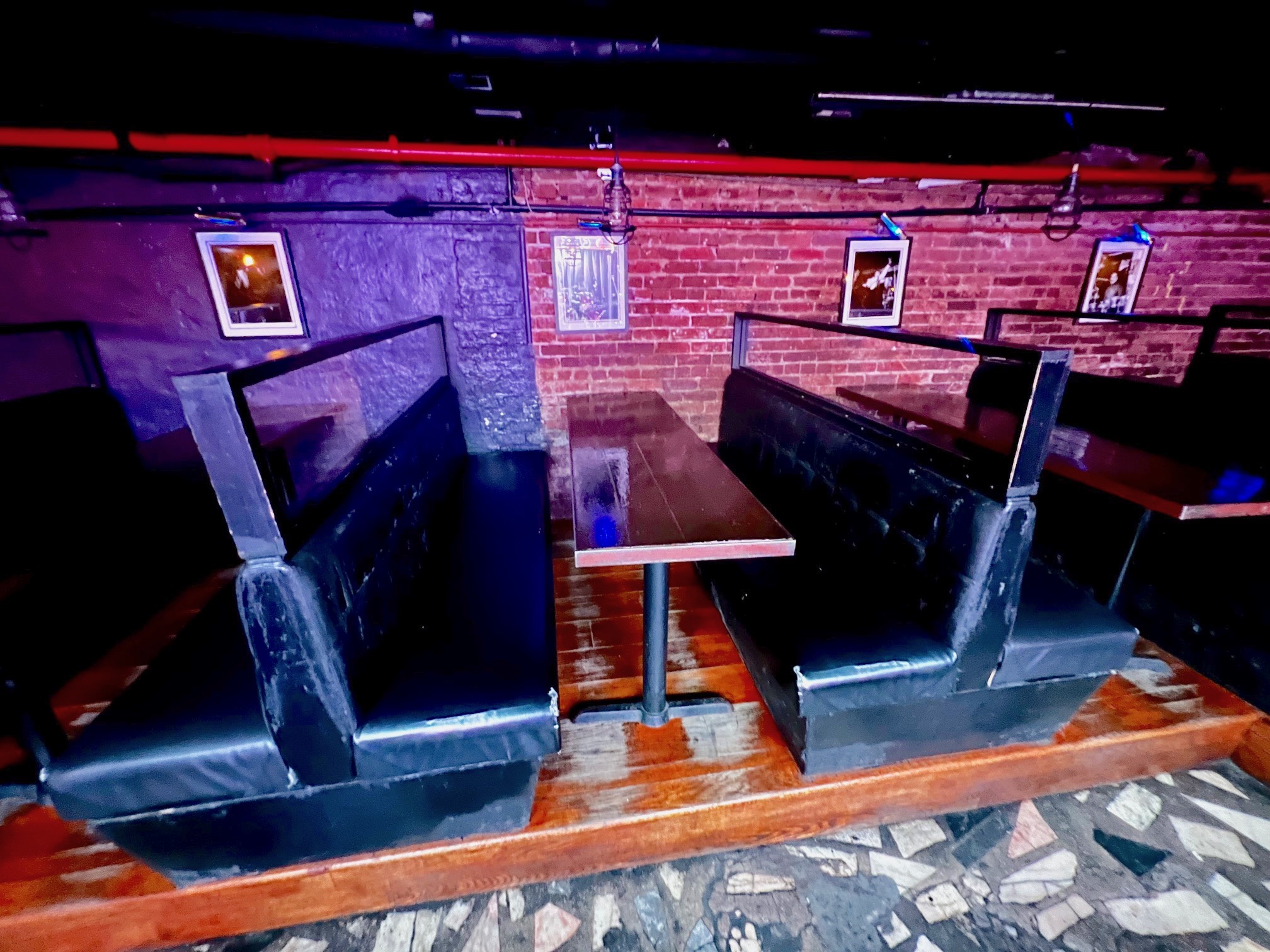
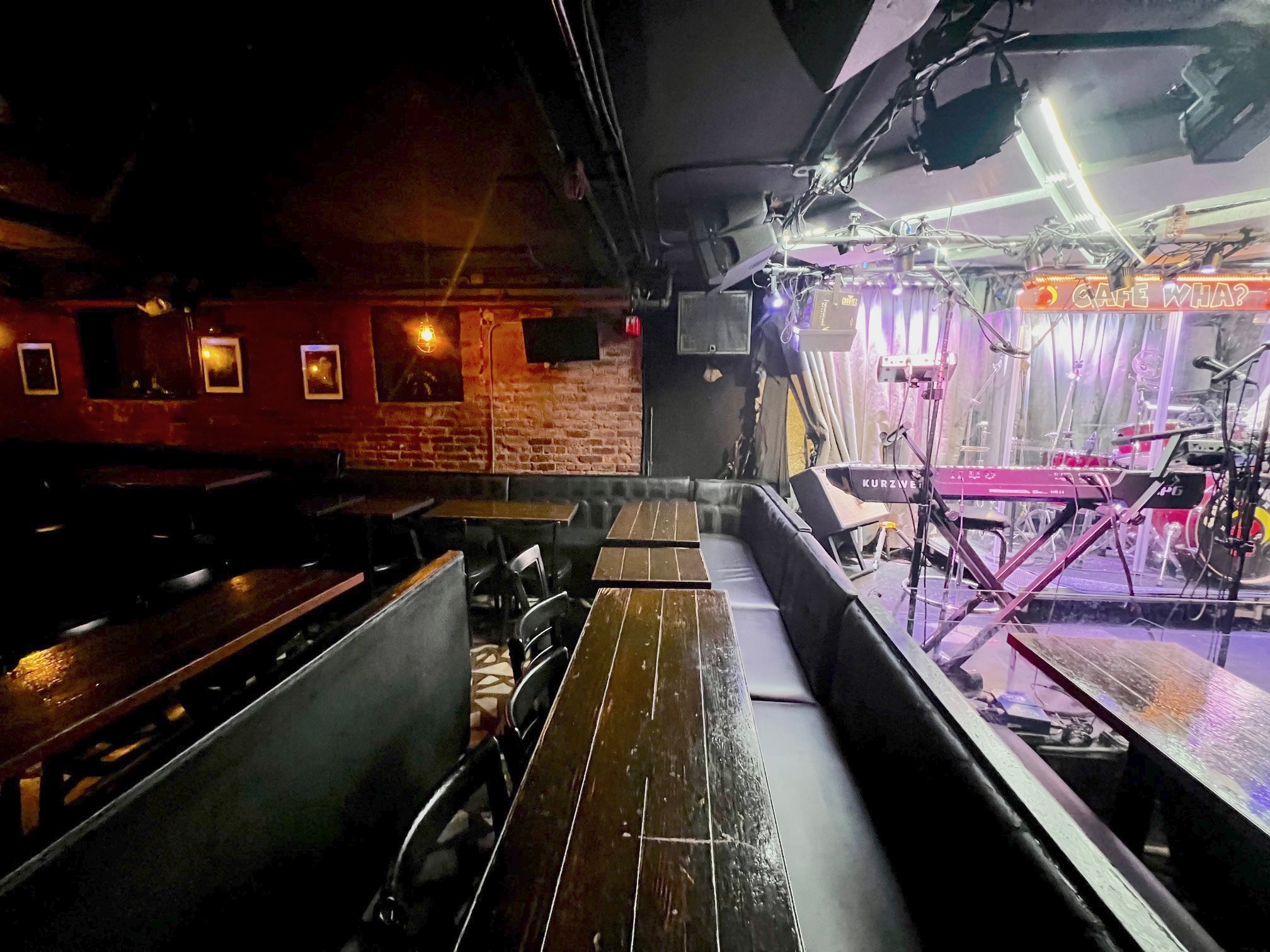

Inside the Wha? 
Inside the Wha? - the Stage 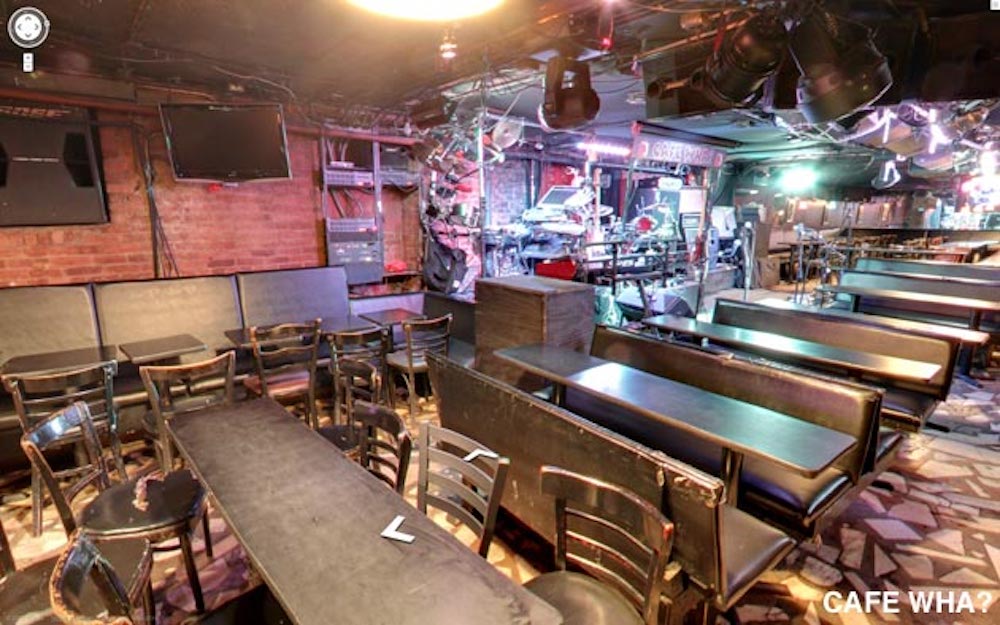
The back exit onto Minetta Lane. This is where the performers enter to get backstage. 
A look down the back steps. 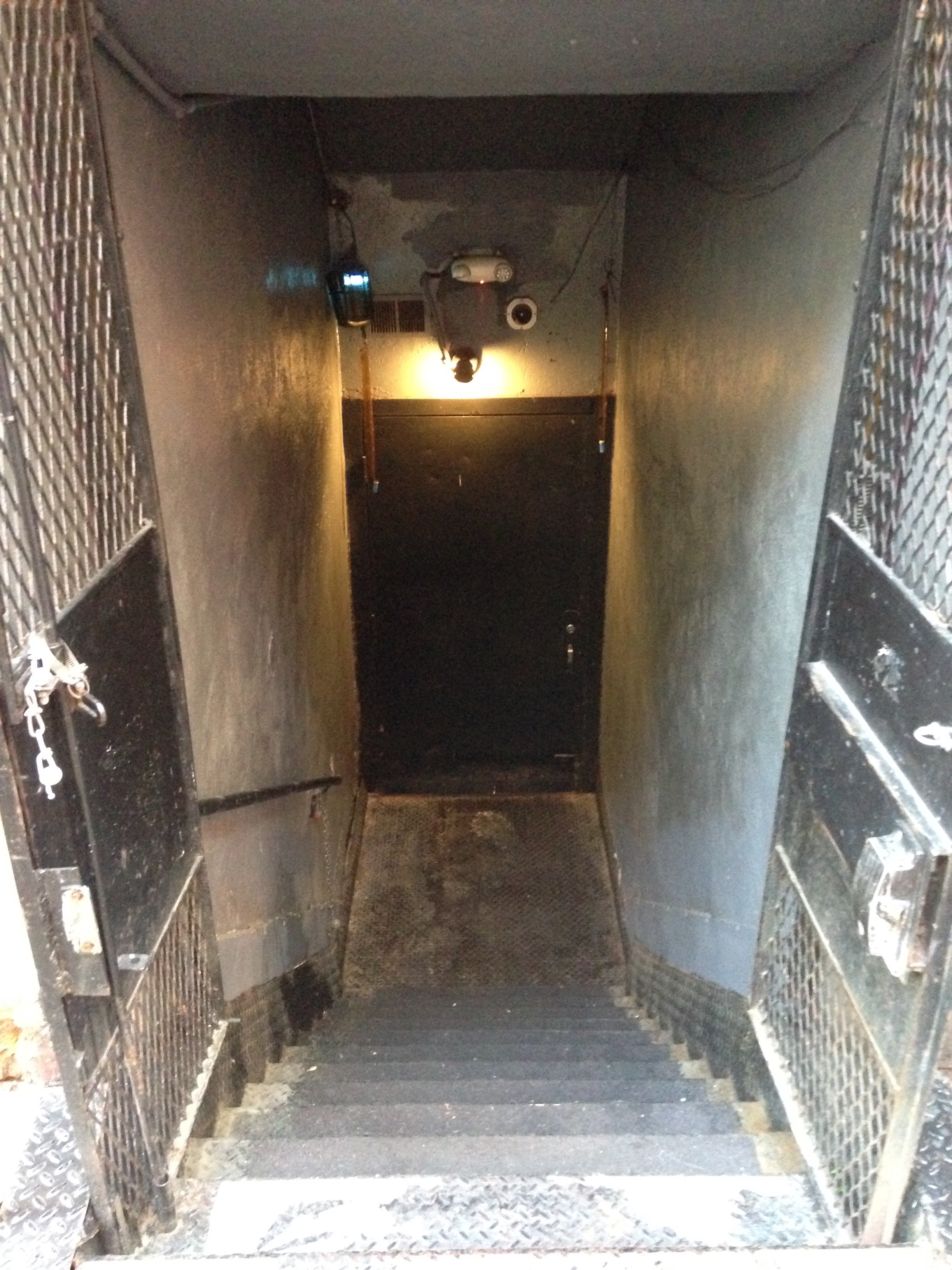
The Players Theater above the Cafe Wha? is one of the oldest commercial Off-Broadway theatres in operation in New York City. (from WIkipedia:) "The Players Theatre contains a main stage with more than 200 seats and a 50-seat black box theatre, as well as four rehearsal rooms. It was built in 1907 as a carriage house where it served police horses until it was converted into a theatre in the late 1950s. Celebrities who have appeared on their stage including young Britney Spears and Natalie Portman in Ruthless! in 1992". Inside the theater. 
Inside the theater. 
A play in 2024. 
Here's what the theater looks like when empty. The stage in close-up. Looking up from the stage. The Fugs played over 700 performancesg in the Players Theater above the Wha? during 1966 and 1967. During the summer and fall they played three shows a night on the weekends - 8:00, 10:00, and midnight, according to Ed Sanders (one of the Fugs) in his 2011 book 
(photo by Fred McDarrah) From 1966. (click to ENLARGE) 
(photo by Fred McDarrah) Another night in the mid-60's. The sign at the Cafe Wha? door says "Martin St. James." The Fugs are playing upstairs in the Player's Theater. 
Nighttime at the Wha? 
An advertisment for the Fugs at the Players Theater. 
Three of the Fugs pose out front of the Cafe Wha?: Tuli Kupferberg, Ed Sanders, and Ken Weaver. 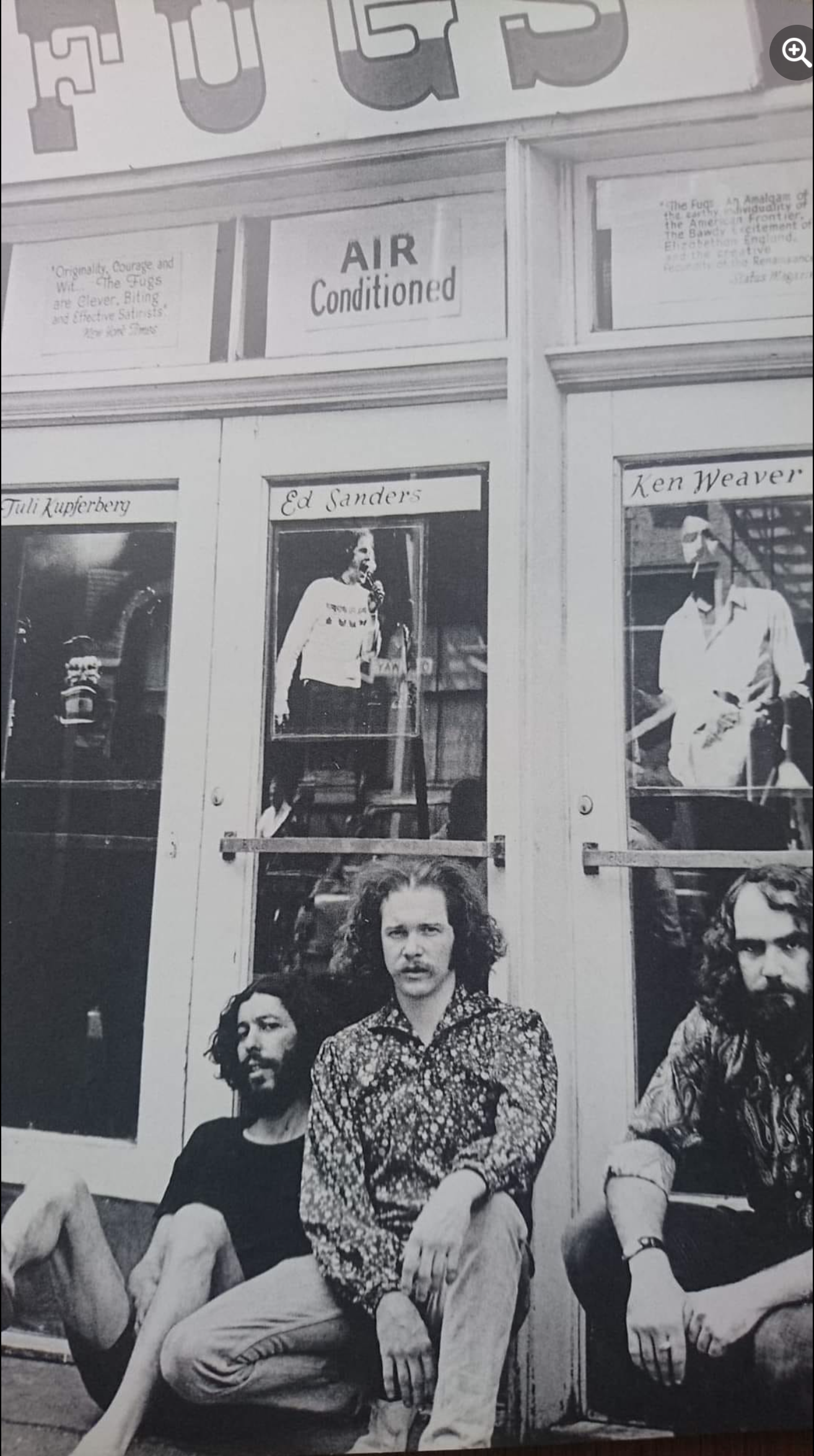
Cafe Wha - the 60's. 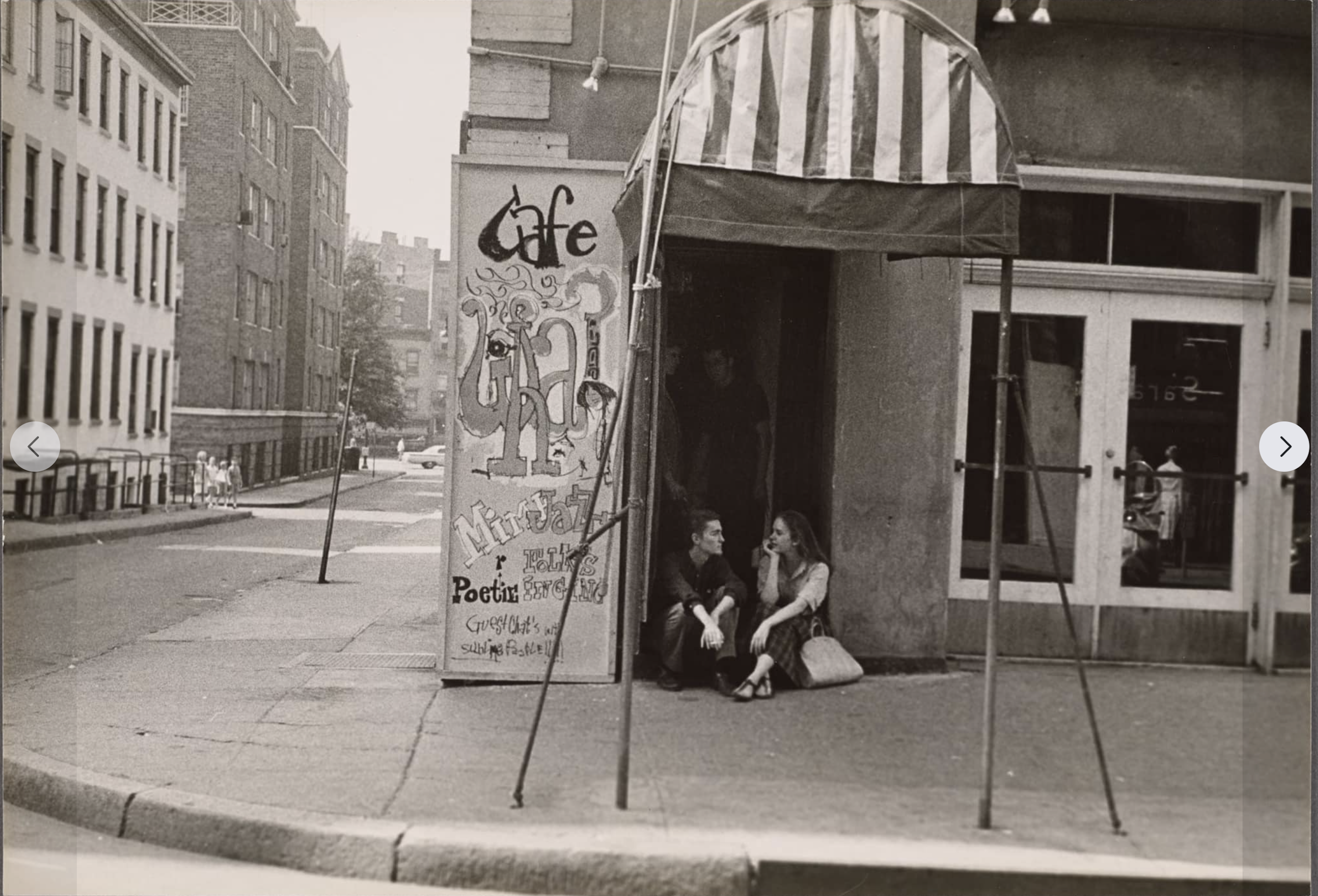
A side view from the New York Times. 
"Rock at the Wha!" 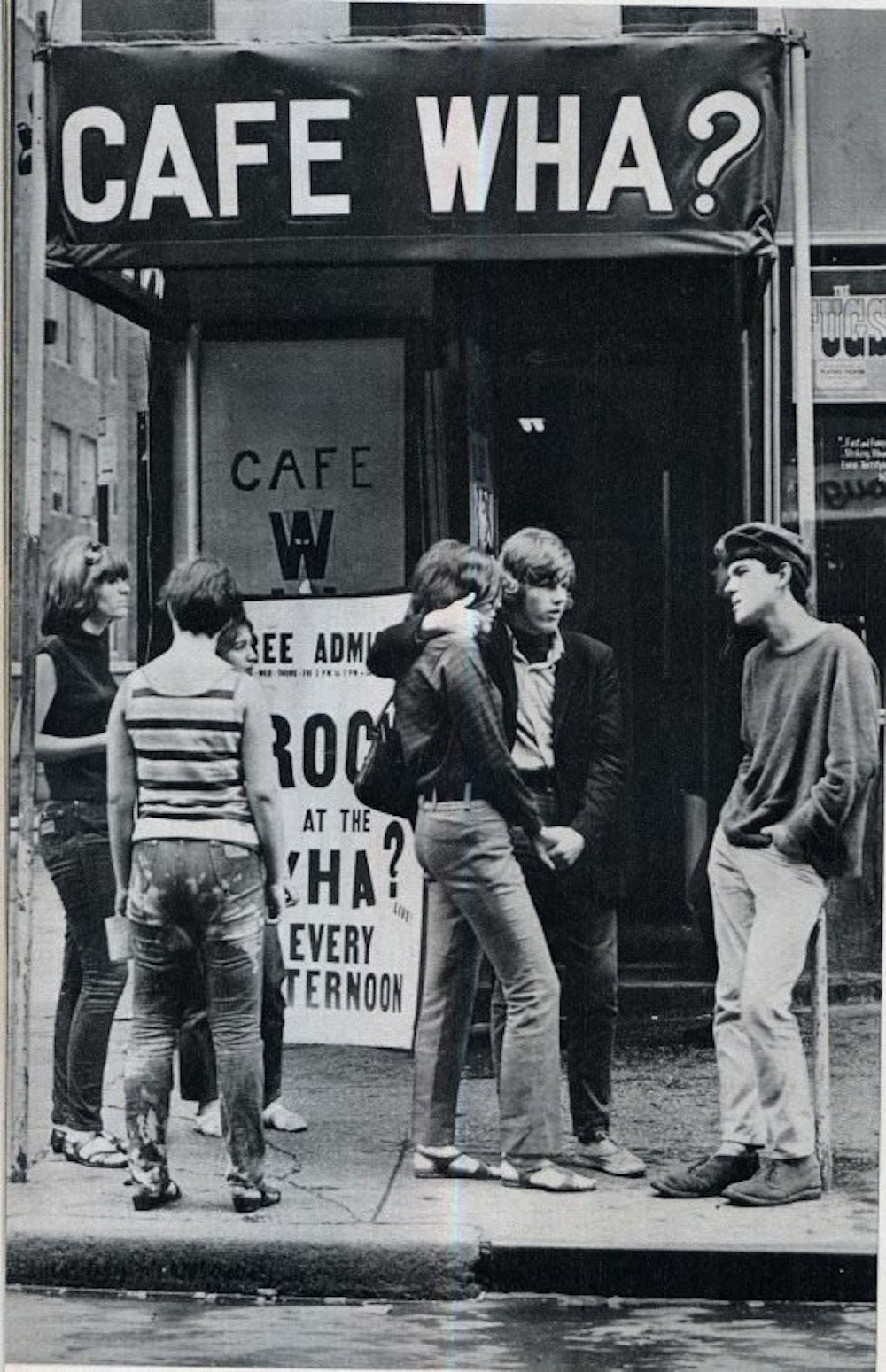
Rock at the Wha? Every Afternoon. 
Leaning on a car outside the Wha? 
Cafe Wha? in the early 1960's. 
More 1960's. NYU Law School is the brick building in the back right. 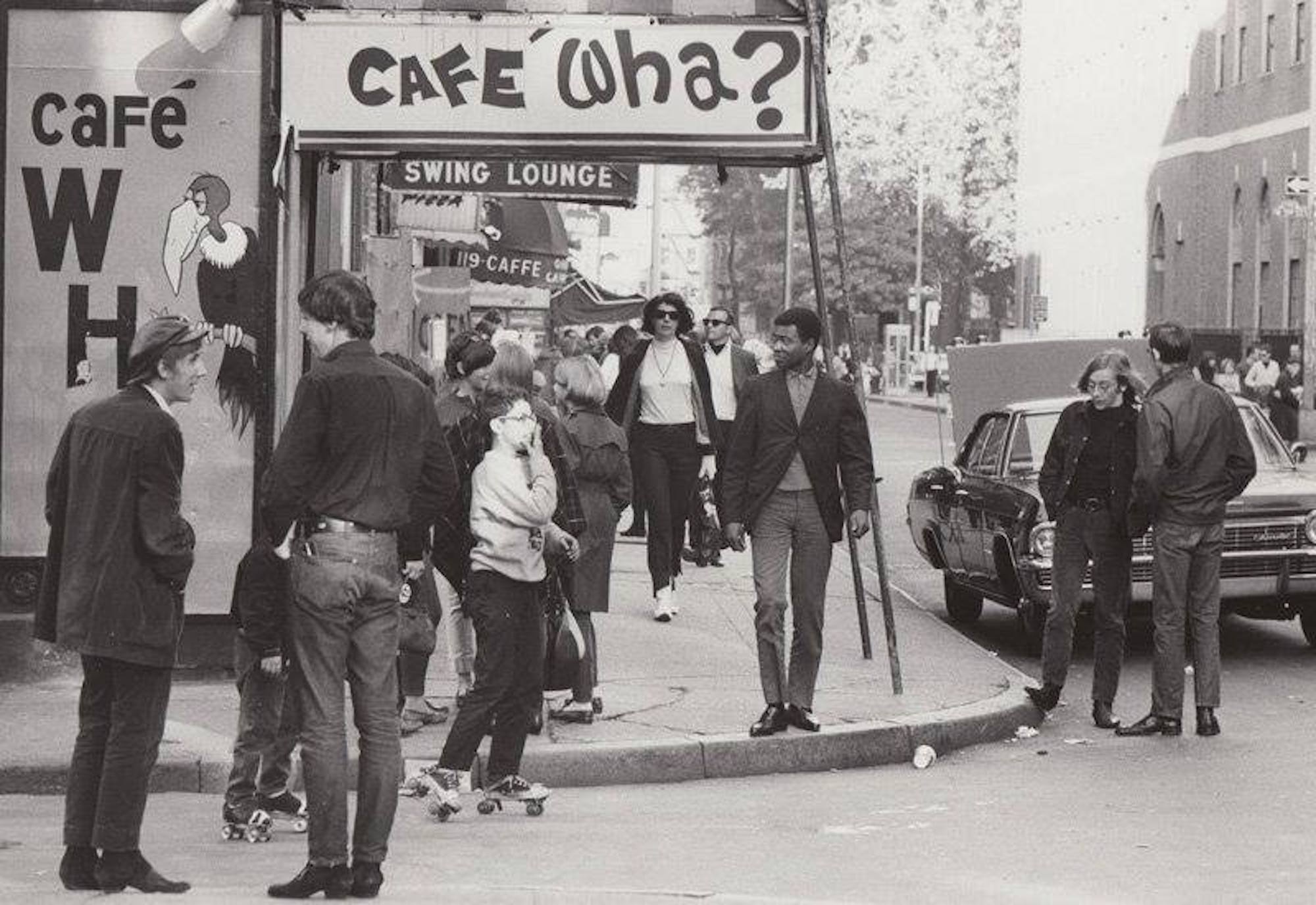
Entrance sign to the Cafe Wha? - 1960's. 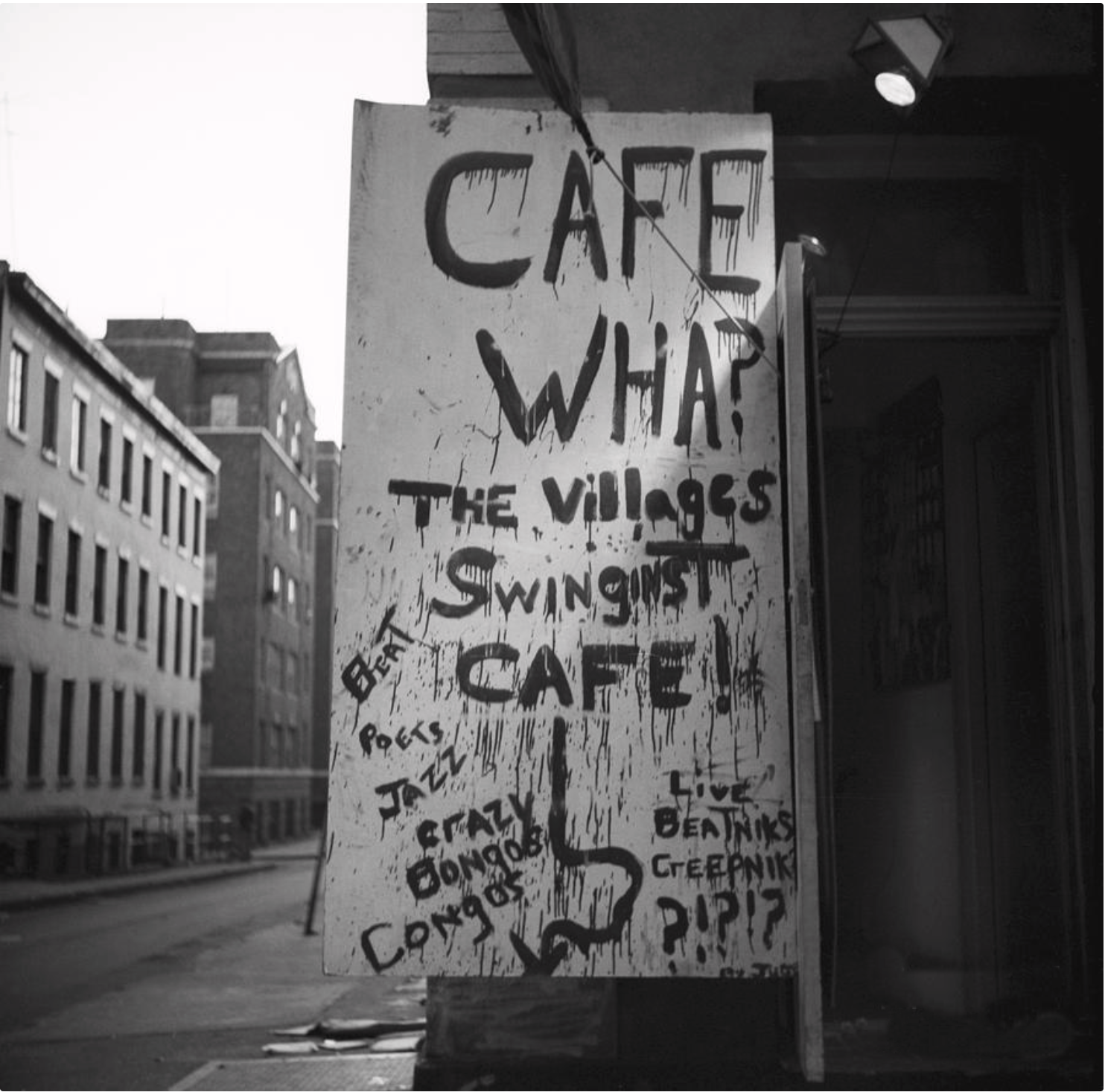
The Cafe Wha? in 1964. From a video clip. 
Cafe Wha? from further up Macdougal Street in the 1960's. 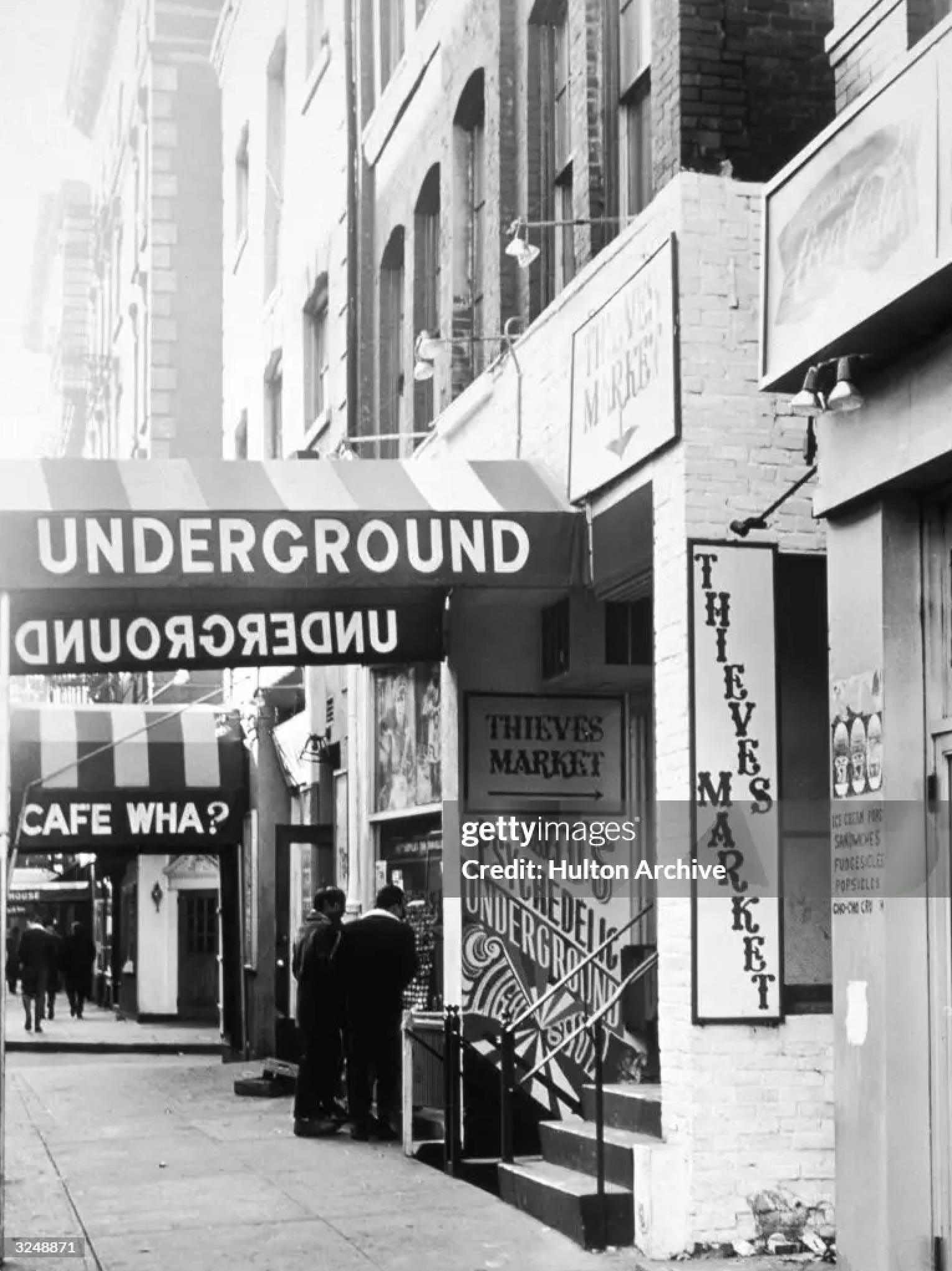
Two kids in the doorway of the Wha? 
A color shot. 
Another color shot from a film. 
Lenny Bruce was one of the many comics who played at the Players Theater.. 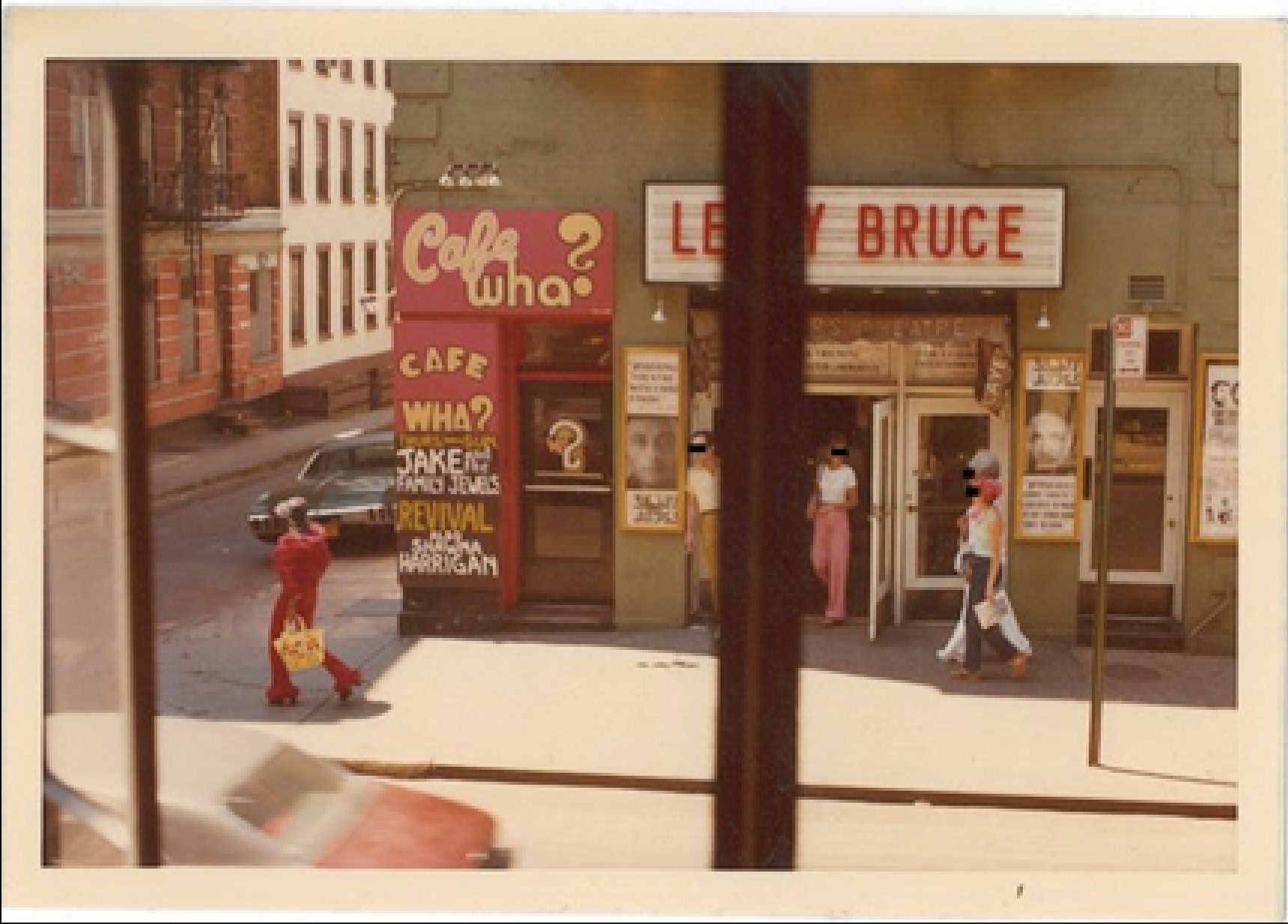
The Cafe Wha? became part of the Feenjon Group of cafes for a while in the 1980's 
After the Cafe Wha closed, for a while on Friday and Saturday nights in 1972 and 1973 it also billed itself as Duke's Dilemma and was a dark disco with strobe lights. It served no alcohol and was open from 9:00 p.m. to 3:45 a.m. You can see it in the rear of this photo. 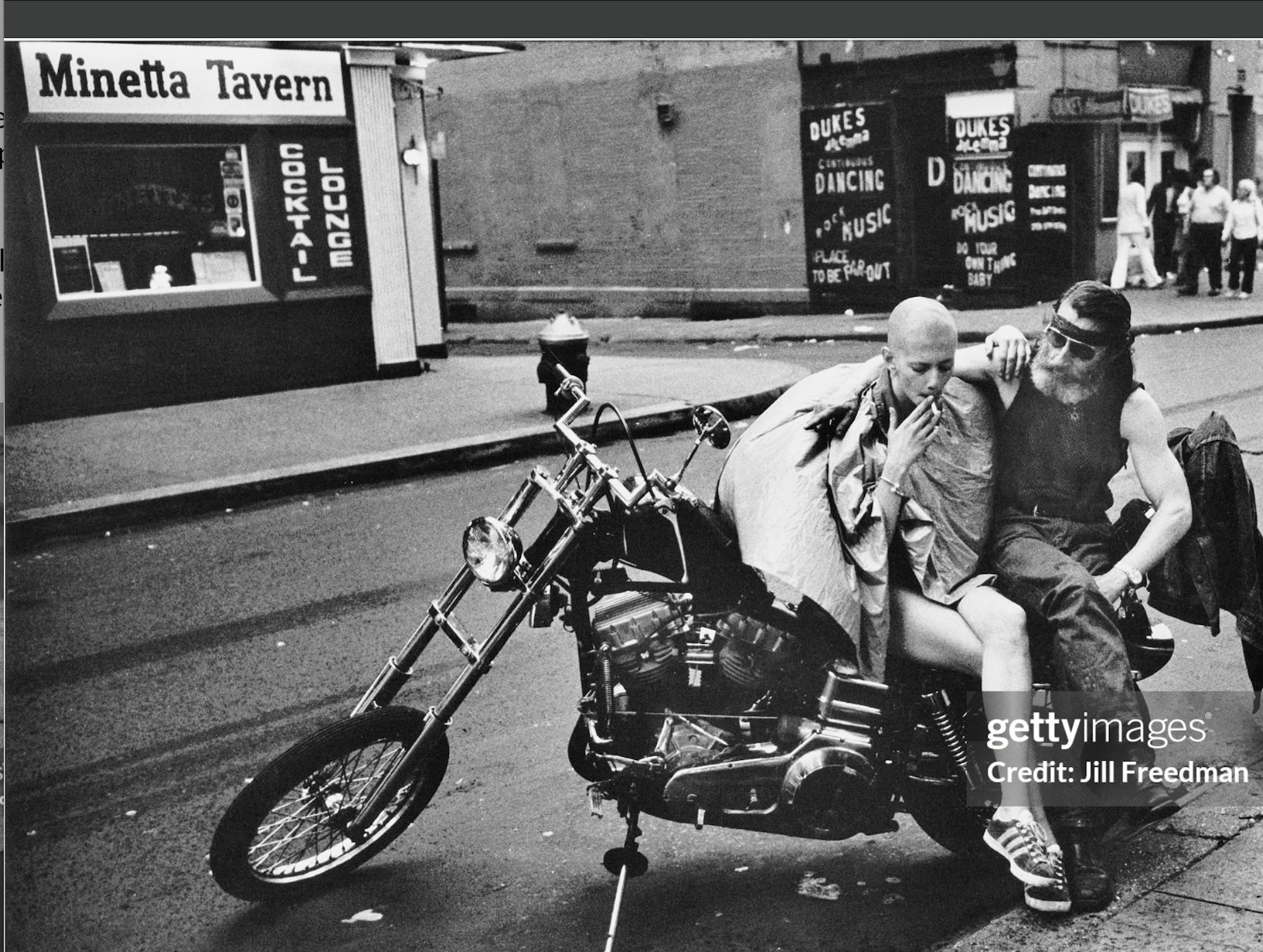
(photo: Jill Freedman) When Bob Dylan first came to New York CIty in the winter of 1961 at age 19, he is reported to have played at the Cafe Wha? the first night he was in town, January 24, 1961. This photo is credited as being taken about two weeks later on February 6, 1961 by Fred McDarrah. In the photo he is playing at the Cafe Wha? with folksinger Karen Dalton and Fred Neil (who would later write "Everybody's Talking" for the movie Midnight Cowboy 
This is what that photo would look like in "Popspot" form - superimposed over the present-day stage. (click to enlarge the photo) 
(Dylan, Karen Dalton, Fred Neil photo by Fred McDarrah) A similar photo was taken probably the same night by Village Voice photographer Gin Biggs. The clothes the musicians are wearing in the two photos are the same. They are standing in the same spots. The microphone stand is in the exact same place. To make the scene clearer, I photoshopped out the guitar strap that was covering Fred Neil's face. You can see the original in the image of the VIlage Voice below. 
Her photo includes a congo drummer on the left, Dylan, Karen Dalton, Fred Neil, and Mark Spolestra, who often played with Dylan in Dylan's first year in New York. (You can see part of Mark Spolesta's checkered shirt in the McDarrah photo above of the same night). Gin Briggs' photo, though taken that same night in February, was published in the Thursday July 20th, 1961 edition of the Village Voice. The caption mentioned that a folk hootenany of sorts had been going on at the Cafe Wha? since "early this year." In a radio interview with Cynthia Gooding in 1961 Dylan told her that he used to play there (at the Wha?) with a guy from 2:00 in the afternoon 'till 8:30 at night and got a dollar and a cheeseburger." About photographer Gin Briggs: Village Voice staff photographer Gin Briggs (probably short for "Virginia") lived upstairs from Lorraine Hansberry, the author of A Raisin in the Sun, at 337 Bleecker Street between 10th St. and Christopher St. After they became friends Briggs became Hansberry's personal photographer in addition to taking photos of street life and local art exhibits. Briggs, five-foot-two, had come from Ponka City, Oklahoma and began working at the Voice in 1957. Brigg's also had a small photography studio on the ground floor of 61 Grove Street, with a window facing Sheridan Square. One day she put a poster up in her window that said "Clean up the Democratic Party," something that disturbed the local political machine run by Carmine DeSapio. Her landlord threatned her with eviction but she kept up the sign saying, "It's a free country, Isn't it?" Later Lorainne Hansbury would write a play based on the incident, called "The Sign in Sidney Brustein's Window," that was produced on Broadway in 1964, 1972, and 2023. A quick story about Fred Neil and the Cafe Wha? (from Wikipedia) Starting in February 1961 Fred co-hosted an afternoon hootenanny at Cafe Wha? with Lou Gossett (later a famous actor). Bob Dylan recalled that when he arrived at the Village, he was advised to seek Neil there, and, when he did, Neil invited Dylan to join him on stage . . . Later in his career, Neil formed a duo with Vince Martin.In his memoir, Richie Havens recalls that while Neil and Vince sang their version of Ray Charles's "What'd I Say?" they would continue performing while making their way out the cafe's side door onto Minetta Lane, then returning through the front door, while keeping the song going. Here's an image of the Village Voice from July 20, 1961. It shows the picture described above. 
Here's a closer look. 
Jay and the Americans recorded their second album there in 1963. It looks like there is a sliding curtain behind the band, covering up a brick wall. 
This is a photo showing a performer and the inside of the Cafe Wha? from the 1960's. It's from the New York Public Library files and taken by a photographer named Walter Silver. You can see the entrance door in the center back where you can read the word "ladies." 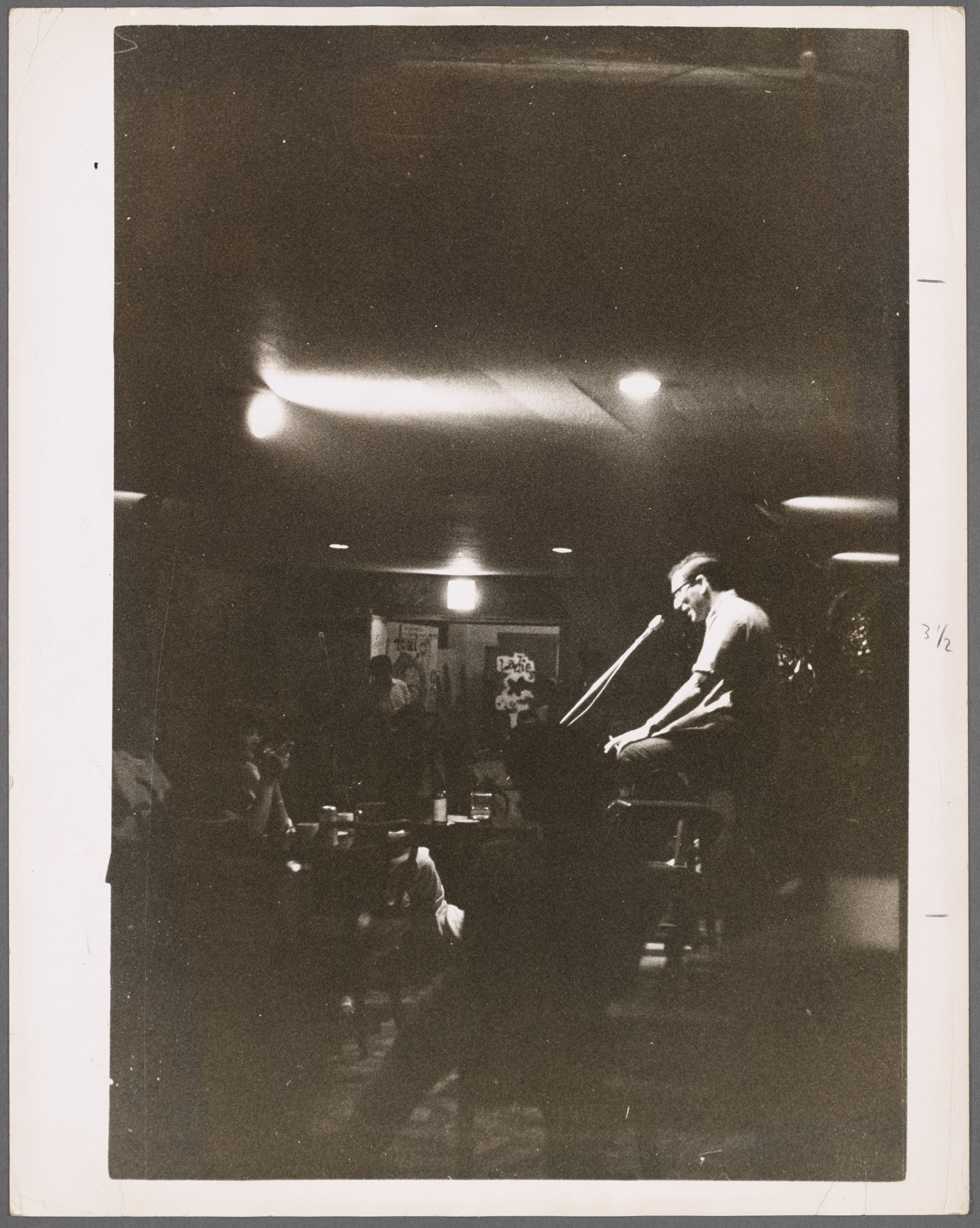
This is a picture of New Jersey high school student Bruce Springsteen (on the left) and his band The Castiles outside of the Cafe Wha? sometime between late 1966 and early 1968. During those 2+ years, The Castiles played 30 performances at the club. 
Here's a shot of the Castiles playing live on the stage at the Cafe Wha? The Castiles usualy played on weekends to teen audiences when the Wha? didn't serve alcohol. They would play from one in the afternoon until six o'clock, alternating with about six other bands. Each band played about six sets throughout the day to teens from Manhattan, Long Island, and New Jersey. For the afternoon the chairs were moved so it would seem more like a discotheque. For this they were rewarded with "six dollars and all the potato chips they could eat." (That $6 dollars is the equivalent of about $60 today) as quoted from Bruce Springsteen FAQ by John D. Luerssen (2021). The band would commute from Asbury Park both days during the weekend, almost a 3 hour commute each way. 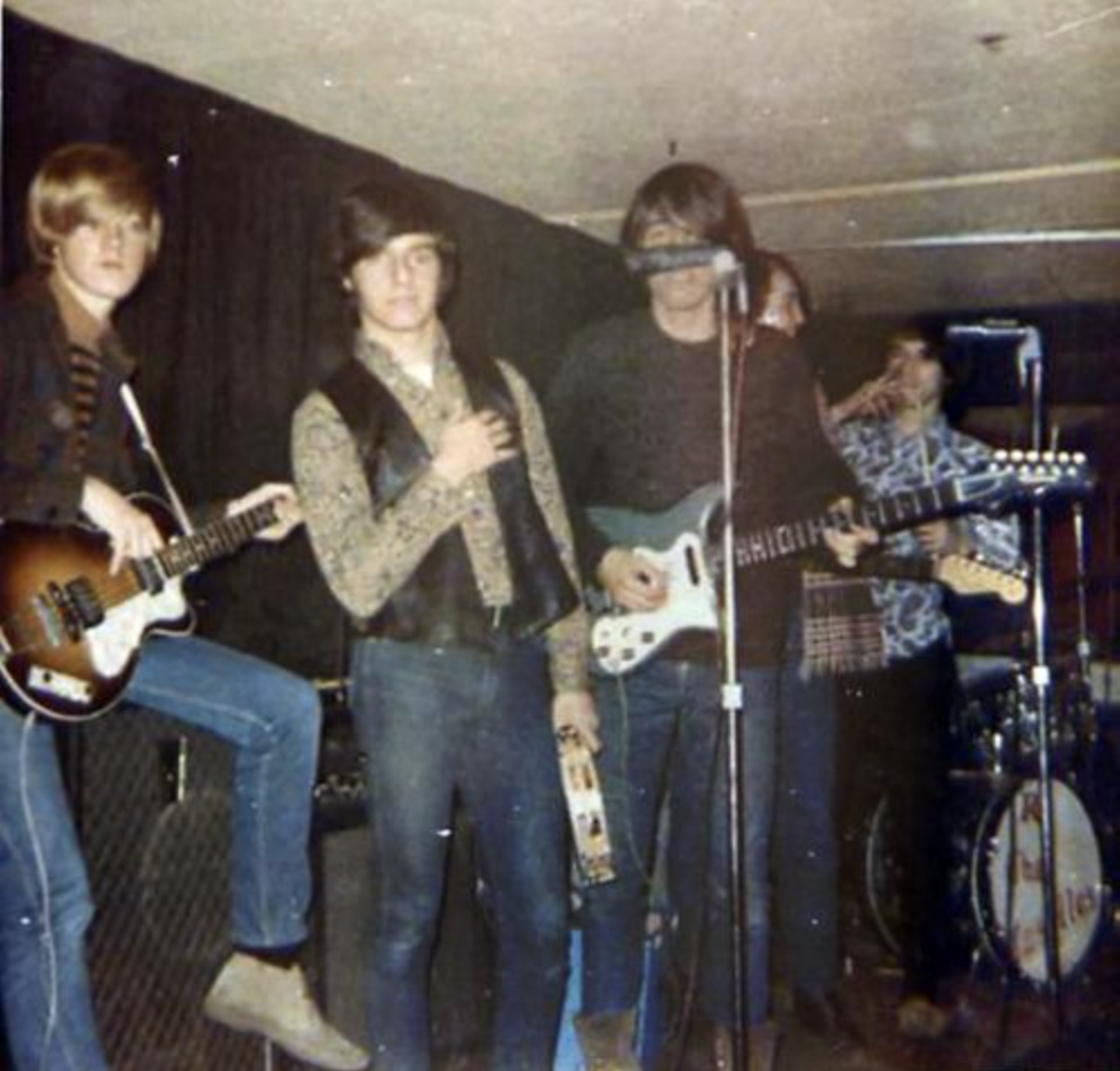
Here's a composite picture of the band where they would take a break. It's outside the rear side door of Cafe Wha? at the intersection of Minetta Lane and Minetta Street. 
The building at 115 Macdougal Street that houses the Cafe Wha? and the Player's Theater was originally a stable for horses, then a gas station, then in 1959 was turned into a bar and theater. This picture was taken around 1925 when it was a stable.. The Cafe Wha? door is at right. We are looking down Minetta Street from MacDougal Street. 6th Avenue is in the far background. 
Here's a close up. For some reason the sign seems to read #118 not #115. There is a picture of a horse. The sign probably reads "Macdougal Stables" 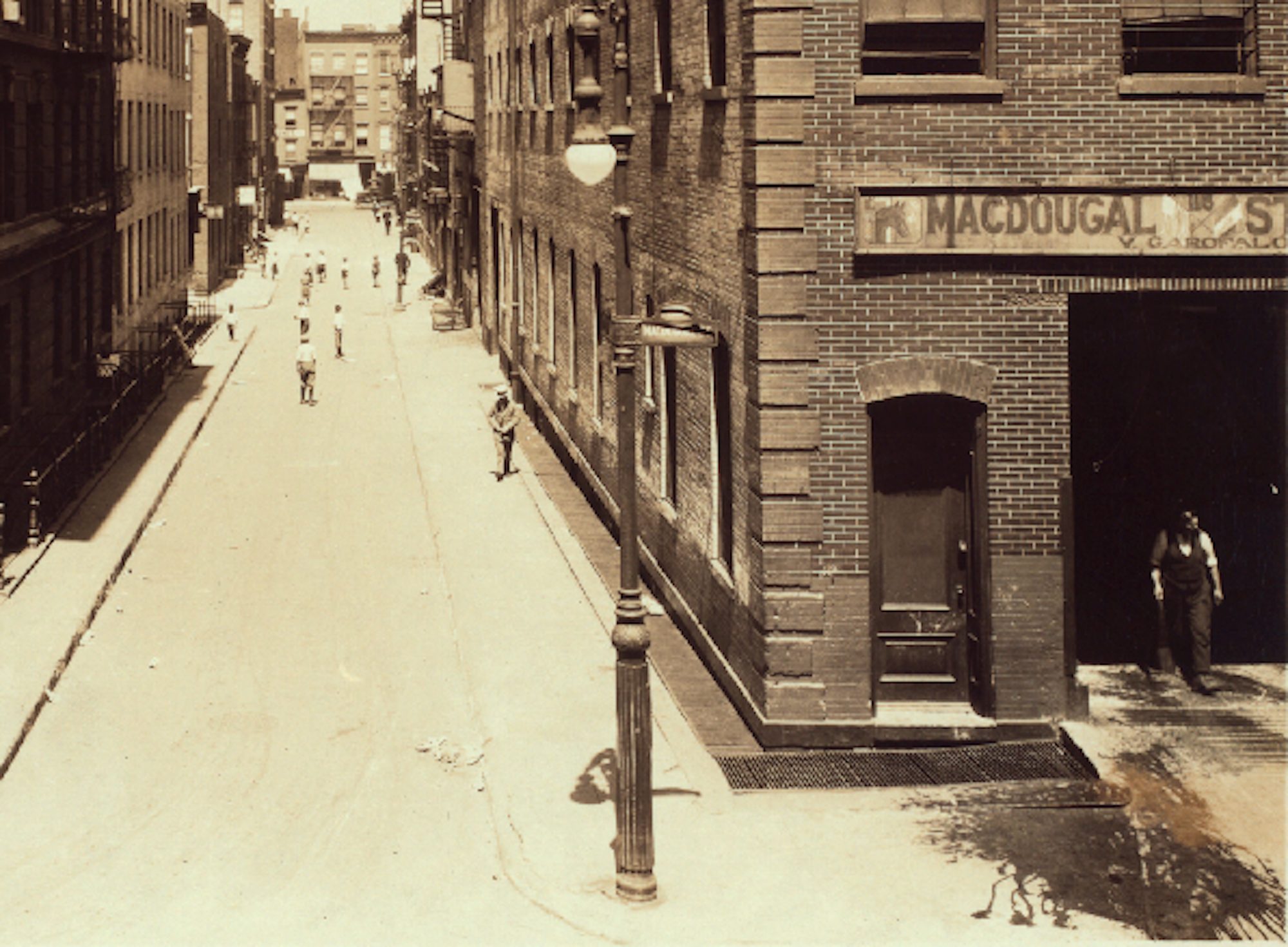
This photo is from May 23, 1933 by P.L. Sperr, a photographer who photographed many of the buildings in Manhattan for the city records. NYPL photo caption: "Notice the beam projecting over the tall upper window in the center. A pulley was fastened to this so that bales of hay could be hoisted up to the hayloft." 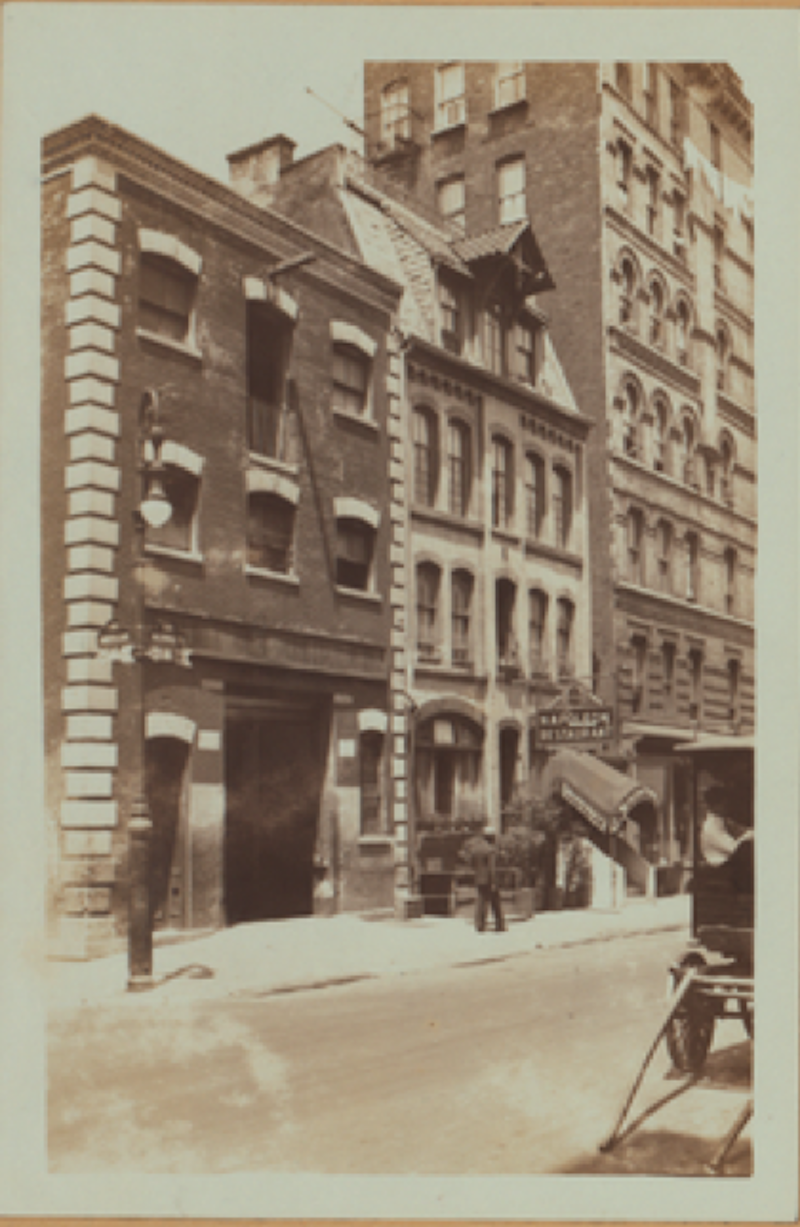
(source: NYPL archives) A closer view. 
Here's a picture of the Cafe Wha? building from 1939. It now serves gasoline. The sign means "Block 243 of Manhattan," "Lot 23 of that block" and "M" for "Manhattan." 
(NYC 19040's tax photos) This is the building next to it, up Macdougal Street. 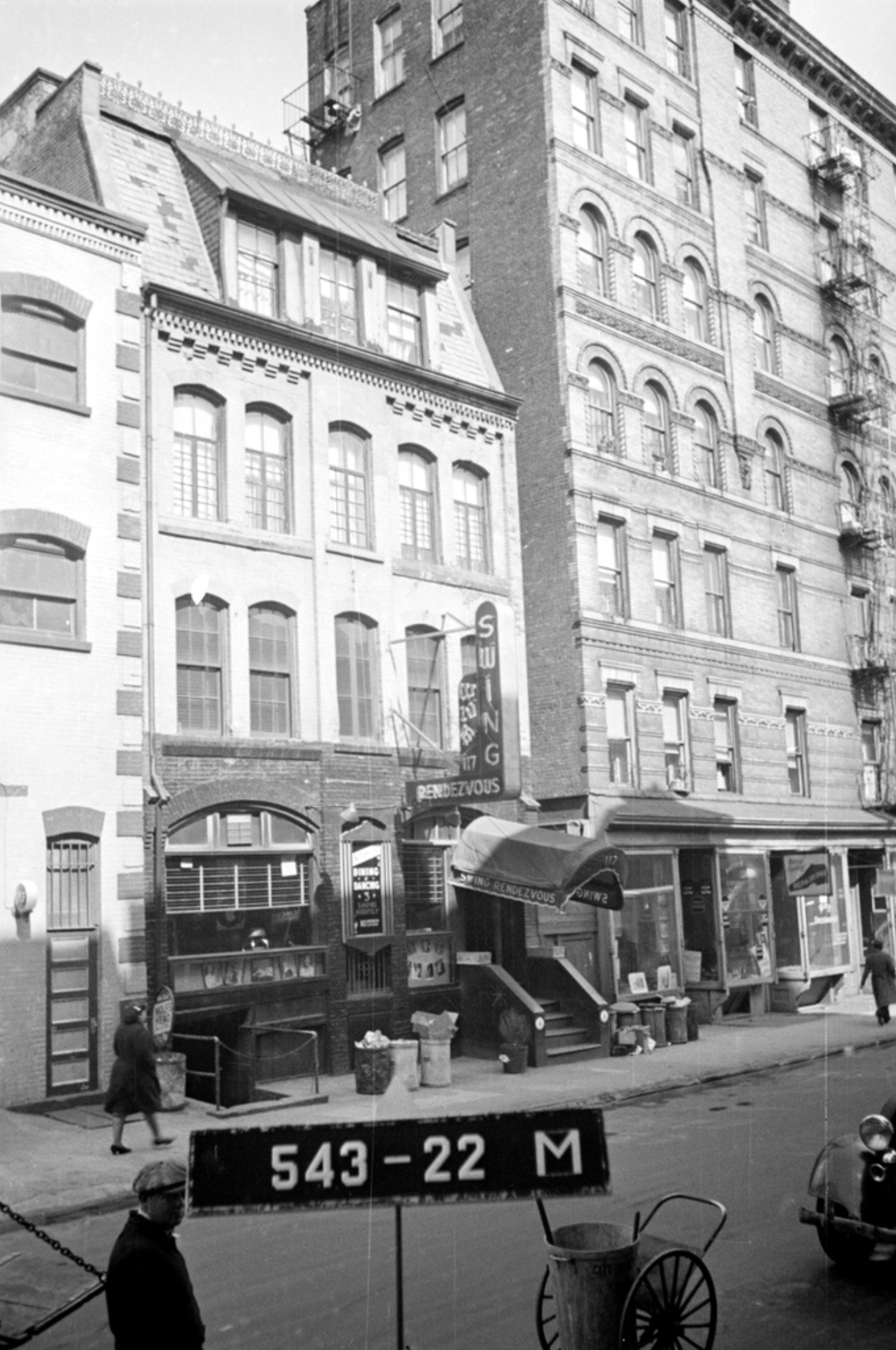
(NYC 19040's tax photos) Here are those two pictures spliced together. 
(NYC 19040's tax photos) A map showing the Macdougal Street of 1962, showing the Cafe Wha? at number 115.. 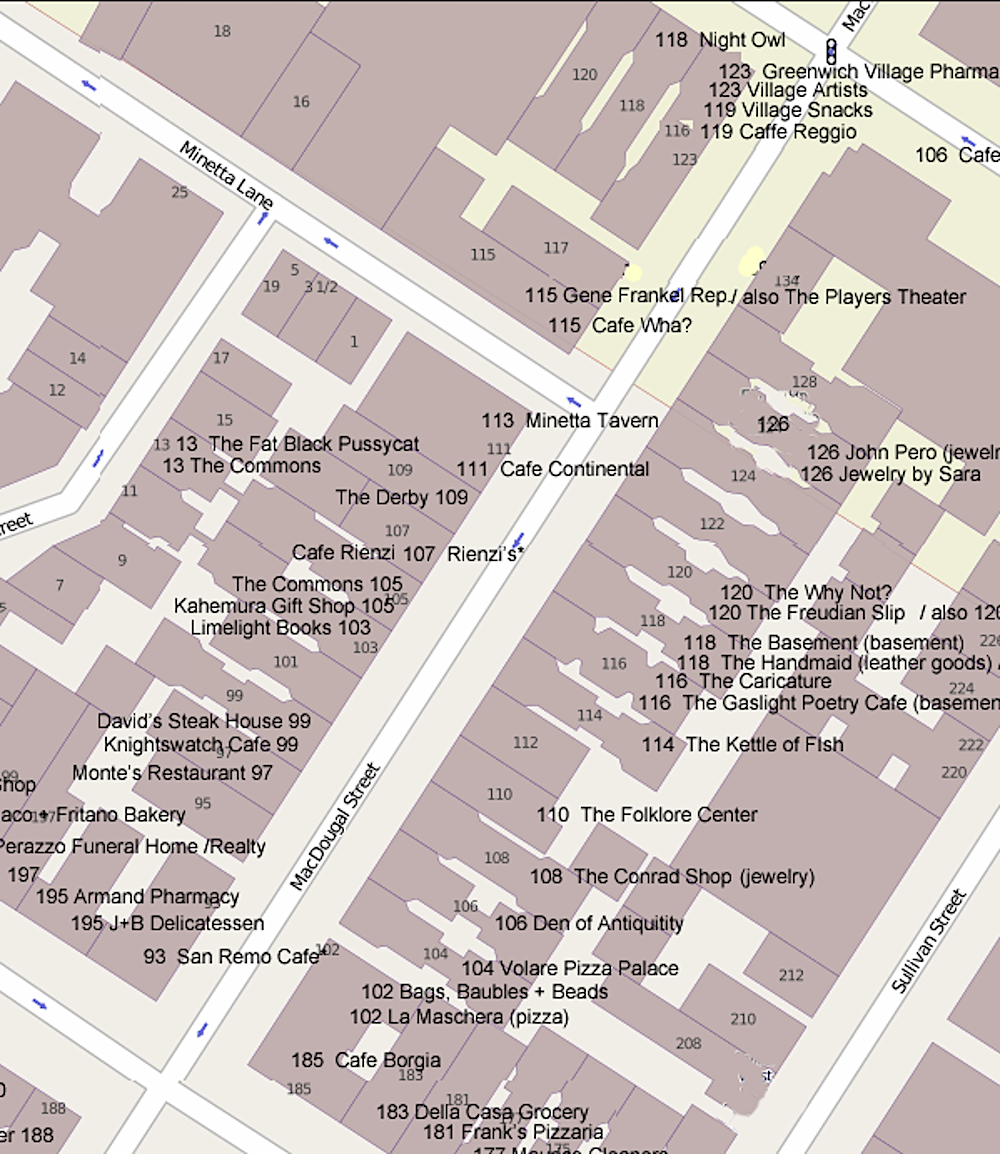
(NYC 19040's tax photos) This is an edited version of the Wikipedia entry for the Cafe Wha? which, in brief, tels its history and some of the famous musicians and stand-up comics who have played there. "Cafe Wha? is a music club at the corner of MacDougal Street and Minetta Lane in the Greenwich Village neighborhood of Manhattan, New York City. The club is important in the history of rock and folk music, having presented numerous musicians and comedians early on in their careers, including Bob Dylan, Jimi Hendrix, Bruce Springsteen, the Velvet Underground, Cat Mother & the All Night Newsboys, Kool & the Gang, Peter, Paul and Mary, Woody Allen, Lenny Bruce, Joan Rivers, Bill Cosby, and Richard Pryor. The club's motto is "Greenwich Village's Swingingest Coffee House." Club History The Cafe Wha? was opened in 1959 by Manny Roth, an actor and World War II veteran, at 115 MacDougal Street in New York City. Van Halen singer David Lee Roth is the nephew of Manny Roth, and he and Van Halen performed at Cafe Wha? in 2012. Entered down a steep staircase, the basement space was formerly a horse stable, and Roth laid the marble tile himself. He painted the walls black to make the space seem like a cave. The club was a coffeeshop selling food and drinks, and eventually charged a cover for entry. Musicians, comedians, and performers of all types played throughout the afternoon and evening, frequently being paid through wicker baskets passed through the audience. The space had a capacity of 325 people. Describing Cafe Wha? in his memoir, Chronicles: Volume One, Bob Dylan wrote that it was "a subterranean cavern, liquorless, ill lit, low ceiling, like a wide dining room with chairs and tables." In 1968, Manny Roth stopped running Cafe Wha?, and it was taken over by Menachem "Manny" Dworman, who ran the Cafe Feenjon in the location until 1987. The Feenjon featured Israeli and Middle Eastern music. In 1986, Menachem Dworman's son, Noam, had introduced to the Feenjon the concept of a rock music house band made up of the most talented performers in the area. The band performed for a year at the Cafe Feenjon on Wednesdays and Sundays, quickly becoming so popular that they took over the entire week. In 1987, the club was taken over by Noam, who changed the room back to a rock music format, and changed the name back to Cafe Wha? The Cafe Wha? house band plays dynamic, high-energy versions of popular songs, and encourages an informal atmosphere between the stage and audience. In 1997, Cafe Wha? opened Brazil Night on Mondays, a show created and produced by Andre Alves. The show was performed for over five years to a sold-out crowd, receiving positive acclaim. Notable Musicians Bob Dylan first performed at Cafe Wha? during a "hootenanny" night on January 24, 1961 after hitchhiking across the country. He continued playing at the club as a backup harmonica player during the afternoon. Before she was part of the folk trio Peter, Paul and Mary, Mary Travers was a waitress at Cafe Wha? Based on the recommendation of folk singer Richie Havens, Roth hired Jimi Hendrix as a recurring performer in 1966 . . . Billed as "Jimmy James and the Blue Flames," he played five sets a night, six nights a week. Chas Chandler, the bassist for the Animals, discovered Hendrix at Cafe Wha? and brought him to England to promote his career. In 1967 ansd 1968, Bruce Springsteen's band, the Castiles, played afternoon sets. Notable Comedians Notable comedians who performed at the club early in their careers include Woody Allen, Lenny Bruce, Joan Rivers, Bill Cosby, and Richard Pryor.For more about individual musicians and their experieces at the Cafe Wha? see: 1) Jimi Hendrix: Voodoo Child of the Aquarian Age by David Henderson, pages 73 to 87. 2) Chronicles, Volume 1 by Bob Dylan, pages 9-14. 3) Born to Run by Bruce Springsteen, pages 90-95. 
|
|||


